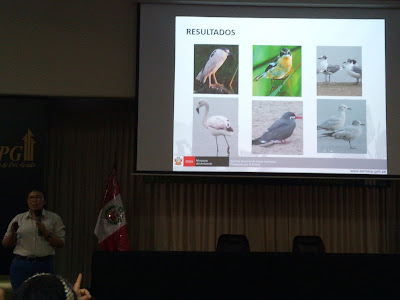The previous week, on days 26, 27 and 28 took place the National Congress of Scientific Research of Natural Protected Areas of Peru, organized by the National Agrarian University La Molina (UNALM), the Pontifical Catholic University of Peru (PUCP) and the National Service of Protected Natural Areas by the Peruvian State (SERNANP), in compliance with the management of its Action Plan that will allow a synergistic interaction between the Universities, research institutes and SINANPE, to encourage greater scientific research in all areas of science in order to enhance and improve the management of the competent authority, conserve biodiversity and contribute to sustainable development.
The venue of the event was held in the auditoriums of the UNALM in La Molina’s district of Lima city, beginning, after the welcome, with keynote addresses and followed by symposiums in the parallel rooms that were categorized as: biodiversity terrestrial, aquatic biodiversity, ecology and management, ecosystem services, society and governance, biodiversity and management of the ANP.
Attended researchers, students and the general public interested in the subject.
It has been a fruitful experience and we can rescue that current technology provides many benefits to research, such as the use of drones, smart detectors through cell phones, trap cameras, computerized germplasm analysis, and DNA coding, among others; it's used, for example, in the monitoring of biodiversity within an NPA (APN in spanish), but sometimes it is harmful, as in the detection of fish species in times of closure by people or companies that have access to these technologies to misuse it; because not only the arduous work of SERNANP, IIAP, UNALM, and scientific NGOs was highlighted, but also the threats that occur during these investigations (deforestation, bacteriological threats, mining, and illegal fishing).
It has been researched both in biotic and abiotic media, confirming the high biodiversity that Peru has; besides the discovery of new species, the use of bioindicators for various purposes, the study of their habitats, the different ecoregions, ecosystem services, climate, geological history, the impact of climate change, the impact of the introduced species and impact anthropogenic; a lot but a lot of very important information that will be used to carry out the management of the ANP, empowering the participation of the populations or native communities who take advantage of these resources on which they depend.
There has been talking of the creation of Marine Protected Areas, MPA: "A work area for the protection and maintenance of biological diversity and associated natural and cultural resources and administered by law or other effective means of control" (IUCN). , 1994); proposing the addition of 2 fishing zones with the objective of protecting up to 10% in the marine space where a large number of species abound, is an opportunity to take advantage of sustainable development with long-term conservation objectives; Since it is currently protected only by 0.47%.
Something that was surprising was to learn that the main objectives of SERNANP, biological conservation, and contribution to sustainable development are limited and this happens when there is a pre-existing zone to the creation of a new NPA, which already have a legal right over it, such as the hydrocarbons industry, which is in line with regulations and good practices in the industry, such as signing agreements with research institutes and with SERNANP to implement biodiversity conservation actions for hydrocarbon projects in tropical forests. But when we say limited, it is because although it is true that a detailed study of the biological groups in the area is carried out, providing work to scientists to make baselines, monitoring, the study of ecosystem services, among other tools; The impact that is generated is considerable despite complying with legal regulations. As the speaker explained: "We try to make the impact less" - The minimization of the impact is carried out by rescuing, relocating and monitoring species of flora and fauna.
On the other hand, there were also information panels, free material, inventories of biodiversity, promotion of organic products of economic value from the ANP.
The event ended with a keynote address and words from the organizers, who advanced us to the realization of the Congress of Natural Areas of Latin America to be held in March, with headquarters in Peru. The closing was accompanied by a typical dance of the jungle and music of the tuna of the UNALM.
This conference has aroused much interest among attendees, in addition to knowing that research within an ANP are completely free and can be made by any natural person eager to learn and by scientists or students. It is only required to process a permit that can take from 2 to 5 days, depending on the modality. (more information on the SERNANP website).
We hope that the number of investigations will increase, our sources of information will be enriched to help maintain our biodiversity, conserving it and contributing to a truly sustainable development.































